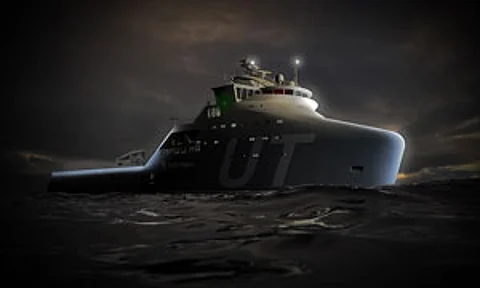

Rolls-Royce Marine is launching its new IT 790 CD vessel design with wave piercing technology for high speed catamarans and trimarans for the offshore market.
"With the UT 790 CD, we can support offshore exploration and production further and deeper while at the same time improving safety and minimising the impact on the environment," said Rolls-Royce Chief Design Manager – Offshore Svein Kleven.
The hull pierces through the water rather than riding on top of the waves, allowing the vessel to run continuously at service speeds regardless of the sea state reducing fuel consumption and improving crew comfort.
This technology eliminates slamming and allows for a smooth ride even in extreme weather conditions. At speeds of 14 knots and violent storm conditions, tank tests have shown no water above forecastle deck level.
The UT 790 CD vessel is a deep-water anchor-handling vessel. Anchor handling operations in deep water rely heavily on the vessel's stability. A main aim in the design process has been to design an inherently stable vessel that also feels instinctively stable.
The vessel meets all existing regulations from the Norwegian Maritime Directorate and all latest international regulations such as SOLAS2009 and Special Purpose Vessel codes and regulations.
The UT 790 CD comes with a full Rolls-Royce Safer Deck Operations (SDO) system, including anchor handling cranes, chain wheel changer and torpedo anchor handling system. Since Rolls-Royce introduced it four years ago, SDO is now seen as standard equipment on high-end anchor handlers. The purpose of SDO is to keep the crew away from danger zones to improve safety, while maintaining operational flexibility and efficiency.
One of many new features on this vessel is the introduction of a three-screw propulsion system, combining a centre controllable pitch propeller with two azipull thrusters with nozzles. As with all other generic anchor handlers from Rolls-Royce, the UT 790 CD comes with a hybrid propulsion system. The multi-drive power electrical system gives high flexibility in different modes; From maximum power operating in anchor handling mode with both mechanical and electrical power engaged, to electrical only in dynamic positioning (DP) or slow manoeuvring mode and mechanical only in transit mode.
This flexibility optimises fuel efficiency and substantially reduces emissions compared to conventional propulsion systems. All Rolls-Royce Bergen engines meet Clean Design class rules without further exhaust clean-up, but catalytic converters can be fitted to the generator sets, giving ninety per cent NOx reductions.
The three-screw solution adds to the vessels flexibility and improved fuel economy. Combining the Azipull thruster with a large single screw controllable pitch propeller ensures superior power and manoeuvrability. The Azipull also creates less resistance in transit position compared to conventional azimuths.
With its special redundant drive solution, the forward azimuth thruster can be powered by two independent switchboards and not just one, and the vessel can achieve the same DP2 capability with its three thrusters then conventional solutions with four.
